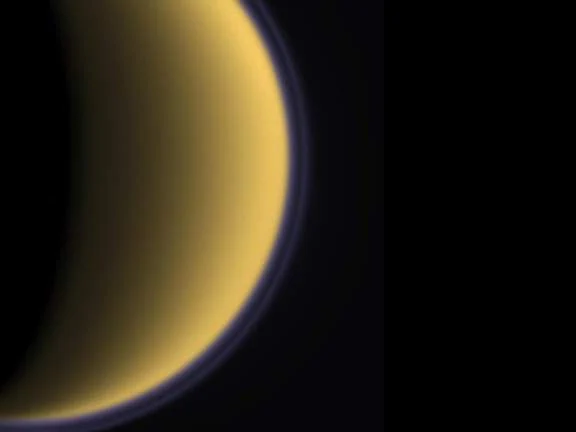Saturn’s giant moon Titan conceals a thick, smoggy atmosphere that is believed to be one of the most complex chemical environments in the solar system.
Essentially, the atmosphere is a productive “factory,” cranking out hydrocarbons that rain down on Titan’s icy surface. This cloaks the planet in soot and, with a brutally cold surface temperature of approximately minus 270 degrees Fahrenheit, forms lakes of liquid methane and ethane.

However, the most important raw ingredient in this chemical factory – methane gas, a molecule made up of one carbon atom joined to four hydrogen atoms – should not last for long because it’s being continuously destroyed by sunlight and converted to more complex molecules and particles.
So how longs has this “factory” been operating? Well, several new studies, using data based on ESA and NASA research, attempt to estimate how much “heavy” methane containing rare isotopes is present in Titan’s atmosphere.
Isotopes are versions of an element with different weights, or masses. For example, carbon 13 is a heavier (and rare) version of the most common type of carbon, called carbon 12. Occasionally, a carbon-13 atom replaces a carbon-12 atom in a methane molecule. Because methane made with carbon 12 is slightly lighter, the chemical reactions that convert it to more complex hydrocarbons happen a bit faster. This means carbon-12 methane gets used up at a slightly faster rate than heavy carbon-13 methane, so the concentration of heavy methane in Titan’s atmosphere increases slowly.
By modeling how the concentration of heavy methane changes over time, the scientists attempted to measure just how long Titan’s chemical factory has been running.
“Under our baseline model assumptions, the methane age is capped at 1.6 billion years, or about a third the age of Titan itself,” said Conor Nixon who is stationed at NASA Goddard. “However, if methane is also allowed to escape from the top of the atmosphere, as some previous work has suggested, the age must be much shorter – perhaps only 10 million years – to be compatible with observations.”
Of course, both of these scenarios assume methane entered the atmosphere in a single burst of outgassing, probably from the restructuring of Titan’s interior as heavier materials sank towards the center and lighter ones rose toward the surface.
“[Yet], if the methane has been continuously replenished from a source then its isotopes would always appear ‘fresh’ and we can’t restrict the age in our model,” Nixon added.
Possible sources include methane clathrates, basically a methane molecule inside a “cage” or lattice of ice molecules. Methane clathrates are found in the frigid depths of Earth’s oceans, and some scientists believe there could be an ocean of liquid water mixed with ammonia (acting as antifreeze) beneath Titan’s water-ice crust. If this is so, methane might be released from its clathrate cages during the eruptions of proposed ‘cryovolcanoes’ of water-ammonia slurry, or more simply could slowly seep out through fractures in the crust.
Kathleen Mandt of the Southwest Research Institute, San Antonio, Texas, also modeled the time-evolution of methane. In Mandt’s paradigm, the concentration of heavy methane is determined from measurements by Cassini’s ion and neutral mass spectrometer, which counts molecules in the atmosphere of different masses (weights). Measurements made by the Huygens gas chromatograph mass spectrometer, which also counts molecules of different masses, were used to constrain the impact of escape on the heavy methane in the atmosphere.
“We compute that, even if methane has been replenished from the interior over time to match or exceed the amounts fed into the atmospheric chemical factory, the process must have been running for a maximum of one billion years,” said Mandt. “If the process had started any earlier, we would see a build-up of methane in the lakes on the surface and in the atmosphere beyond what is observed today.”
Both of the above-mentioned theories seem to confirm Titan’s methane atmosphere must have formed long after Titan itself. Interestingly enough, previous work analyzing the evolution of Titan’s interior indicated the last major methane eruption occurred 350 million to 1.35 billion years ago, while crater counting put the age of the current surface at 200 million to one billion years. However, the most recent theories – for the first time – estimates the methane age from the atmosphere itself at less than one billion years.






